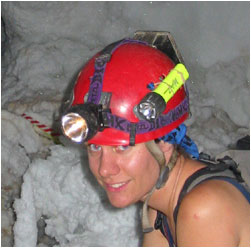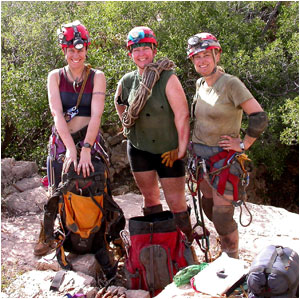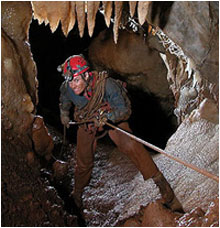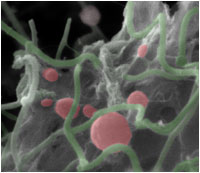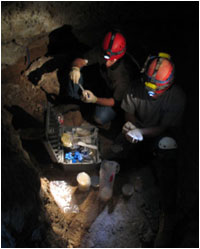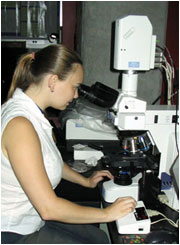
"So what we're trying to do is understand how [microbes] live in these environments and it's very difficult to do because most of the time to get at them, you have to drill down and do a lot of damage. Whereas caves allow us to go in and look at that interaction directly." |
SCIENCE HERO:
HAZEL BARTON
by Marc Airhart
for Earth & Sky
Permission to use this material
was granted by Earth & Sky.
Airhart: So when did you start caving? Barton: When I was 14, I took an Outward Bound course. I actually thought I was claustrophobic and I thought going caving would be a good way to get over it. And I still haven't gotten over it yet — much to my mother's chagrin. Airhart: The claustrophobia or the caving? Barton: The caving! I'm still doing it after all these years! Airhart: Do you ever get claustrophobic in caves? Barton: There's been a couple of times when I've been deep underwater in a submerged cave, cave diving when it's gotten very, very tight. And with the mask and the regulator on your face, very low visibility and being deep underwater and only having so much air, there's been a couple of times that my chest has felt a little bit tight. But that's been about it. So I think I'm officially not claustrophobic.
Airhart: I saw the IMAX film "Amazing Caves," which you were in a few years ago. And I still vividly remember that scene where you're underwater and you're going through a small hole in the rock and you have to take your oxygen tank off and push it through the hole first to fit through because the hole is so small. Just watching it made me feel claustrophobic!
We had to do that shot seven times to get it because the camera couldn't fit. So they had to swim the long way around and then film me coming through. Airhart: You've been a caver most of your life. And you're also interested in microbes. When did you start combining those two interests? Barton: It was about five years ago, I started working for a professor at the University of Colorado called Norm Pace. And he's probably one of the — if not the — preeminent microbial ecologists in the world. And I got into it doing microbial ecology with him. My Ph.D. is just classical medical microbiology. And it's really only recently — in the last 15 or 20 years — that we've realized that there's a world of microbiology outside of those organisms that make us sick. Pretty much everything we know and understand about microorganisms comes from the ones that make us sick. And these are a few hundred species out of the potential 200 million species of bacteria on Earth. So we really don't know anything about the microbial world. Even though we've had the microscope for 300 years, we still don't know what's going on. So I started working with him [Norm Pace] on other projects. And he said, well, why don't you go do some cave stuff. And I said I don't want to do microbiology in caves. Caving is what I do for fun. I don't want to make it my job. The thing is, there were questions in microbial ecology that we could only answer by going into caves. So by going into caves and doing this research, we were able to answer these questions that nobody else could because they couldn't get there to do the research.
So what we're doing now is combining my ability to go where not many people can go in the first place and taking in the knowledge of someone who's a trained microbiologist into that location. So I got more and more into it. And now I'm a full time tenure track faculty here who's job is 50 percent teaching, 50 percent researching microbial ecology in these caves.
Barton: One of the things I was always worried about was that when I started doing this that caving would become a job. But it's not. Now what I find is that when I explore a cave, I'm always looking for clues about how the cave formed. If you find out how a cave formed, you know where the cave's going to go and you can kind of push it in that direction and explore new passages. And this is how you successfully explore a cave. Well, I do the same thing now but I'm not just looking for clues about how the cave formed, I'm looking for clues as to how microbes had a role in that. And it will be surprising. I'll be walking down a passage picking my nose or something and I'll be looking at a rock and I'll go, that's strange, what's that? And I'll just kind of go up to it and poke it with my finger and before I know it, there's another project. But we have to be very careful what we do. It's very easy to go off on a tangent and one of the great things I have is I've worked with some of the very best people in microbiology in the U.S. And they taught me how to really focus on the research. Airhart: So what is the focus of your research? Barton: Primarily what we're trying to do is understand how life lives in very starved environments on Earth. What we think based on study of microorganisms in the environment and the evolution of life is that macroscopic life — life you can see on the surface of the planet — may be an evolutionary burp. And that the majority of life actually lives in the subsurface down through the rock of Earth itself to several miles below our feet. So as much life as you see on the surface may be insignificant compared to the life below our feet. So a lot of that life is going to live in what we would consider an extremely starved environment — an environment with maybe one milligram per liter of energy. In other words, if you take a grain of sugar and dissolve it in a liter of water, that's about how much energy is supporting these ecosystems living in the subsurface.
So what we're trying to do is understand how they live in these environments and it's very difficult to do because most of the time to get at them, you have to drill down and do a lot of damage. Whereas caves allow us to go in and look at that interaction directly. So that's why caves are such a valuable tool in doing that.
They can also chew into the rock — so there are sources of energy in the rock itself. And these organisms are able to go in and pull these sources of energy out and as a result, change the structure of the rock. In doing so, they leave behind a mineral biosignature. And this biosignature is very stable because now basically they've taken one rock and changed it into another rock, so they are stable over geologic time. And that's a very good tool for astrobiology. If we can understand the changes that these organisms create in rocks under certain conditions and with certain nutrient sources, you can use those as markers on Mars or maybe on other planets with rock outcrops to look for evidence of past life. On Mars, when they looked for evidence of past water, they looked for minerals that can only form through the processes of water. Well we're looking for minerals that can only form through the processes of life. Airhart: So how is that work going? Barton: We've actually got microorganisms growing in the lab that were extracted from these cave environments that have no nutrient supply. These came from Carlsbad Caverns in New Mexico last June. We haven't given them any food. They're growing in distilled water — very pure water. And they're precipitating a mineral and we can't figure out what it is. It's like nothing we've ever seen before. They're scavenging enough nutrients out of distilled water that they actually precipitate a crystal. With this idea of trying to understand how starvation affects the microbes, we were looking at different locations within Carlsbad and how nutrients affected how these microbes interacted with the rock in which they lived. And what we found was that when there were plenty of nutrients coming in, a drippy area where these nutrients were coming in from the surface, they really didn't make any change to the structure of the rock. It stayed pretty much the same. We went to starved areas of the rock where nothing was coming in from the atmosphere. These microbes had chewed into the rock so far that the first inch and a half was just a powder — that was all that was left of the rock, a very fine powder. Everything else had been digested. Airhart: I understand that another reason to study microbes in starved environments is that they may yield new antibiotics to treat human illnesses. Can you tell me about that? Barton: Most of the antibiotics that are used today come from the same group of microorganisms called the actinomyces. It's a very good group to produce antibiotics from. When these organisms starve they produce antibiotics as a way of grabbing nutrients from their neighbors — basically, they kill their neighbor and suck all the nutrients out of them. What we're trying to do is take that to another group. If we look at organisms that only live in starved environments, can we find new branches on the tree of life that contain microorganisms that produce antibiotics? If we can, are they different enough in structure and mechanism of action than anything we have now that when we use these on a patient the chance of antibiotic resistance occurring are much, much lower? Airhart: So what's an example of a disease you hope to find antibiotics for? Barton: One that's really significant for people in the United States is caused by an organism called Staphylococcus aureus. And this is the same bug that causes pimples and gives you boils. It's just a nasty little organism. And the thing that's unique about it is it can grow in virtually any tissue in the body. Most organisms can not because your immune system is so good at protecting yourself that they can only grow in your lungs or kidneys or your intestines. This guy can grow anywhere. So you can get an infection anywhere. And now we have a multi-drug resistant form of this because it's very good about picking DNA up from the environment. And very quickly, there developed a multi drug resistant version of Staphylococcus called MRSA — Methacylin Resistant Staphylococcus aureus. If you go to nursing homes or hospitals, there are MRSA wards, because if you take a patient who is uninfected and put them next to a patient who has MRSA, because there's nothing you can do to stop that new patient being infected with MRSA and then there are no drugs that you can use to treat them. Now we had one drug left to treat them and that was Vancomycin. And as long as we had that, if someone was on death's door, at the last minute, we could pump them full of Vancomycin and save their life. Well they've just found a Vancomycin resistant version of Staphylococcus aureus. So it's now resistant to every known antibiotic that we have. There's nothing we can use against it.
So we're now in the pre-antibiotic age when it comes to dealing with this pathogen. So if you have an infection with this organism, there's nothing we can do to help. The only thing we can do is supportive care — the same things they were doing 100 years ago.
Barton: It's very scary. And the thing is the drug companies want to make a billion dollars on a drug that cures erectile dysfunction. It's like, "Well, rich people don't die of this often, so who cares?" Agh! Airhart: So you're trying to develop drugs that will help? Barton: No. I don't think so. I'd like to say yes. It's not my area of expertise. I'm good as a microbiologist at finding these things. The pharmacology of purifying and testing these things is way over my head. I have collaborators that do that. My problem is I'm too much of a scientist. And the question is always the big carrot. I know that sounds terrible — I should be more of a humanitarian than I am. I'd like to draw more awareness to it, that it's an issue. And I think with the IMAX movie, there was at least an opportunity to get people excited about this kind of research and think it was valuable and important. Airhart: So why do you do this work? Barton: Ever since I was a little kid, it's always been, "Why?" Someone once told me it only takes four "why?"s to get to cutting edge science. You know. Why is the sky blue? Well, the atmosphere scatters light. Why does the atmosphere scatter light? Well, the atmosphere acts as a prism and splits light. Why? All of a sudden you're into advanced physics. So I always have to know how things work. You kind of gravitate towards the things that intrigue you the most.
And when I was, oh, crikey, 12, we were doing this thing in biology class — it was our first microbiology lab ever. And we had to go find microbes. So I brushed my hair over this petri dish and something really disgusting grew out of it and I thought that was the coolest thing. And there's a lot of gratification — not so much now because these organisms that grow in these caves, it takes six months to see anything — but the gratification of doing something one day and your result is there the next day. There's certainly something about that.
|
| Written by Marc Airhart for Earth & Sky Permission to use this material |
*Internet Required to view links* Earth & Skyis a non-profit organization committed to describing humanity's work to understand itself and its relationship to the Earth. The radio series and Web site provide a clear voice for science, nature and people in a complex world.The Barton Lab Hazel Barton's cave science Web page! Find out more about her research on the microbes that live in caves. National Speleological Society (NSS)studies, explores, and conserves cave and karst resources; protects access to caves; encourages responsible management of caves and their unique environments; and promotes responsible caving. Carlsbad Caverns National Parkcontains more than 100 known caves, including Lechuguilla Cave—the nation's deepest limestone cave at 1,567 feet (478m) and fourth longest. Intimate Strangers: Unseen Life on EarthCheck out this PBS series about microbes, the first life forms on Earth. |
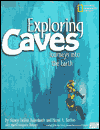
Exploring Caves: Journeys into the Earth
by Nancy Holler Holler Aulenbach, Hazel A. Barton, Marfe Ferguson Delano
 |  | 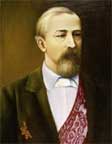 |  |
| Alan Turing laid the theoretical groundwork for the first computer. | Albert Einstein believed in the power of imagination. | Alexander Borodin was an accomplished chemist, composer and staunch advocate of women's rights. | Ameen Abdulrasool is a young inventor who developed a portable navigation system for the blind. |
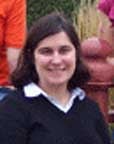 |  |  |  |
| Amy Charkowski works on the front lines of protecting Earth's food supply. | Andrea Mia Ghez is an astrophysicist best known for her discoveries about the black hole at the center of our galaxy. | Ariel Ruiz i Altaba Scientist - Photographer combines art and science to research how cells are generated and formed. | Audrey Penn: Just Do It is a medical doctor who has devoted herself to studying diseases that affect muscle control. |
 |  |  | 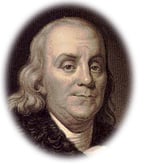 |
| Augusta Ada Byron developed the world's first computer program while struggling with her own personal hardships. | Barbara McClintock a distinguished geneticist and Nobel laureate | Ben Carson is the chief of neurosurgery at Johns Hopkins University Hospital. | Benjamin Franklin was an inventor, diplomat, writer, and a huge influence on American history. |
 |  |  |  |
| Beth Rickard Environmentalist is an advocate of solar as the energy of the future. | Charles Darwin is the father of modern biology. | Chiaki Mukai is the first female Japanese astronaut. | Christiane Nusslein-Volhard is a Nobel Prize winner and pioneer genetic researcher. |
 |  |  |  |
| Claudia Gerwin: Keeping the Neurons Firing researches how nerve cells relay messages to each other. | Clifford V. Johnson is a string theorist who studies the makeup of the smallest particles of the universe. | Connie Samaras has created media archives for deep space voyages. | Courtney Schumacher is an atmospheric scientist and educator committed to mentoring young women interested in science. |
 |  |  |  |
| Cristina Diaz: Biologist studies intertidal and tropical sponges. | Dame Cicely Saunders founded the modern hospice to provide compassionate, holistic care to the dying. | Darlene Ketten studies stranded whales and dolphins. | Debbye Turner became Miss America and pursued her dream to become a veterinarian. |
 |  |  |  |
| Dilfuza Egamberdiyeva Environmental Microbiologist cares for the Earth's soil, researching ways to produce microbes to control plant diseases. | Dr. Alexander Langmuir Langmuir's work in epidemiology has saved millions of lives. | Dr. Barbara Ross-Lee became the first African American woman dean of a US medical school. | Dr. Caldicott has been a lifelong anti-nuclear activist. |
 |  |  |  |
| Dr. Edward Jenner discovered the vaccine. | Dr. Elizabeth Kalko and the Jason Project studies bats in the Panamanian rainforest. | Dr. Elvia Niebla Soil Scientist is dedicated to soil conservation. | Dr. France Cordova is a renowned astrophysicist who has broken gender and cultural barriers. |
 |  |  |  |
| Dr. Gloria WilderBrathwaite was inspired to provide health care to the poor in the innner city. | Dr. Govindappa Venkataswamy cares for the eyes of millions of people in India. | Dr. Inés Cifuentes Seismologist works to improve science programs for students in Washington, DC. | Dr. Karen Plaut has been a pioneer in animal science research. |
 |  |  |  |
| Dr. Kay Jamison is both an expert on, and a sufferer of, Bipolar Disorder. | Dr. Kristi Curry-Rogers is an accomplished paleontologist who travels the globe in search of dinosaur digs. | Dr. Michael DeBakey is the father of modern open-heart surgery. | Dr. Patch Adams gives the practice of medicine a humorous twist. |
 | 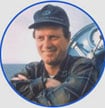 |  |  |
| Dr. Richard Murphy Marine Biologist educates others about the sea and ways to protect the oceans for the future. | Dr. Robert Ballard and the JASON project bring scientific exploration to children around the world. | Dr. Rosalie Bertell Anti-Nuclear Nun is a renowned scientist, eco-feminist and peace activist. | Dr. Sara W. Lazar Neuroscientist - Meditator researches the effects of meditation on the brain. |
 | .jpg) |  |  |
| Dr. Sue Savage-Rumbaugh is a scientist dedicated to the study and conservation of bonobos. | Dr. Susan Love is committed to women's health issues. | Dr. Zeda Rosenberg is working to provide women with a way to protect themselves from contracting HIV/AIDS. | Enrico Fermi was one of the 20th century's greatest physicists. |
 |  |  |  |
| Erich Jarvis observes song birds and uses his training with molecular biology to learn about brain behavior. | F. Sherwood Rowland discovered the 'greenhouse effect.' | Fati Kirakoya: L'Oreal-UNESCO, Women in Science Fellow is a researcher committed to helping find solutions to end the AIDS crisis. | Frederick Banting was the co-discoverer of Insulin. |
 |  |  |  |
| Friends of the Sea Lion rescue, treat, and release these mammals back into the ocean. | Gail Kaaialii: Biologist investigates the origins of life and helps others value all life forms. | Galileo was the first to use a telescope to observe the stars and planets. | George Washington Carver is famous for experimenting with plants. |
 |  |  | 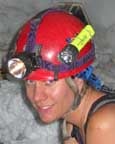 |
| Gertrude B. Elion developed the AIDS drug, AZT. | Gina Gallant is an inventor whose passion is protecting the environment. | Grace Murray Hopper was a computer visionary. | Hazel Barton combines her passion for caving with researching microbes. |
 |  |  |  |
| Irene Ayako Uchida helped find the link between radiation and birth defects. | Irene Curie specialized in nuclear physics, the science of studying the nucleus of the atom. | Jack St. Clair Kilby invented the microchip. | Jane Mt. Pleasant is an agricultural scientist who looks to the past to meet today's farming needs. |
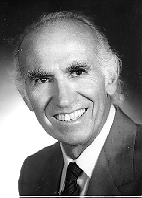 |  |  |  |
| Jonas Salk discovered the polio vaccine. | Kathy Sullivan was the first American woman to walk in space. | Leonard Adleman improves lives with his work in DNA technology. | Leonardo da Vinci was an artist and a scientist ever curious of the world around him. |
 |  |  | 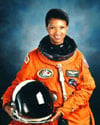 |
| Louis Pasteur 's discoveries advanced the practice of medicine. | Luz Maria Rodriguez-Fernandez conducts cancer research to help understand the disease process. | Madame Curie received the Nobel Prize for her discovery of Radium. | Mae Jemison dreamed of going to space since childhood. |
 |  |  |  |
| Magdalena Hurtado is an anthropologist who studies the Ache people of Paraguay. | Marie Curie discovered radioactivity as an atomic property, opening the door to 20th century science. | Meenakshi Wadhwa studies meteorites and the processes involved in their formation. | Nikola Tesla was the father of many modern inventions. |
 |  |  |  |
| Orville and Wilbur Wright were brothers determined to build a better flying machine. | Paul Farmer has dedicated his life to treating people in the poorest nations in the world | Paul Munsen Solar Oven Man manufactures sun ovens, which harness the sun's rays to provide an environmentally safe source of energy. | Paul Sipiera led an expedition into Antarctica to find meteorites for NASA. |
 |  |  |  |
| Philo T. Farnsworth ,the inventor of the television. | Robert Koch was an important medical researcher of the 19th century. | Rokhaya Gueye treats malaria and raises awareness about women's health issues in Senegal. | Shannon Hackett studies the genetic diversity and evolution in tropical birds. |
 |  |  |  |
| Sir Alexander Fleming : his discovery of penicillin saved millions of lives. | Srinivasa Ramanujan made groundbreaking contributions to mathematics. | Stephanie Jenouvrier UNESCO-L'Oreal Women in Science Fellow is a population ecologist researching the effects of climate change on emperor penguins. | Stephen Hawking is a renowned theoretical physicist who writes about 'black holes'. |
 |  |  |  |
| Tania Ruiz is an astrophysicist committed to science education and helping women reach their goals. | Thomas Alva Edison holds the record for number of patents filed. | Tom Chau Biomedical Engineer uses science and technology to maximize opportunities for people with disabilities. | Tom Dibblee is a legendary geologic mapper. |
 |  | 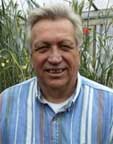 |  |
| Usha Varanasi is the first woman to lead a Fisheries Science Center. | Vladimir Kosma Zworykin is called 'The Father of Television'. | Wes Jackson was a professor who returned to the land to advance sustainable agriculture practices. | Wilson Bentley was the first person to photograph a single snowflake. |
 |  | ||
| XIV Argonauts broadcasted their explorations of the Channel Islands. | Zohra Ben Lakhdar is a physicist from Africa who does research on atomic spectroscopy. |
 |  |  |  |
| Abigail Adams mended the riff between two former U.S. presidents. | Ada Aharoni works for peace between Israelis and Palestinians with poetry. | Adi Roche took responsibility for helping orphans of nuclear disaster. | Alice Waters created the world famous Edible Schoolyard Project. |
 |  |  |  |
| Alicia O'Brien was the inspiration for Cherie Bennett's novel, Zink. | Amy Biehl gave her life to ending apartheid in South Africa. | Amy Charkowski works on the front lines of protecting Earth's food supply. | Andrea Mia Ghez is an astrophysicist best known for her discoveries about the black hole at the center of our galaxy. |
 |  |  |  |
| Angela Brooks is an architect responsible for the future of her city. | Ann Armstrong-Dailey founded Children's Hospice International. | Anna Akhmatova is considered one of Russia's best poets. | Anna Jarvis is the mother of Mother's Day. |
 |  |  |  |
| Anne Frank : 'When I write, I can shake off all my cares.' | Annie Mansfield Sullivan Macy developed new methods for teaching blind and deaf students. | Artemisia Gentileschi was an important Post-Renaissance painter. | Audrey Penn: Just Do It is a medical doctor who has devoted herself to studying diseases that affect muscle control. |
 |  |  |  |
| Augusta Ada Byron developed the world's first computer program while struggling with her own personal hardships. | Aung San Suu Kyi seeks democracy for Burma. | Bella Abzug was a New York Congresswoman who fought for women's rights. | Beth Rickard Environmentalist is an advocate of solar as the energy of the future. |
 |  |  |  |
| Catherine Malonza saved her brother's life. | Cathy Freeman wins races and respect for the plight of native Australian people. | Chiaki Mukai is the first female Japanese astronaut. | Chief Wilma Mankiller was the first woman to serve as Principal Chief of the Cherokee Nation. |
 |  | 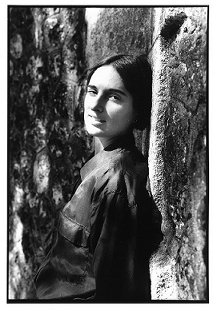 |  |
| Christiane Nusslein-Volhard is a Nobel Prize winner and pioneer genetic researcher. | Christine de Pisan was a 15th century French poet. | Claire Lalanne founded the Center for Nutritional Recovery. | Clara Barton was known as the 'Angel of the Battlefield.' |
 |  |  |  |
| Clara Hale has helped hundreds of children | Clara Shortridge Foltz was the first woman to practice law in California. | Claudia Gerwin: Keeping the Neurons Firing researches how nerve cells relay messages to each other. | Connie Samaras has created media archives for deep space voyages. |
 |  |  |  |
| Constance Baker Motley became the first African-American woman judge on the largest federal trial bench in the US. | Corrie Ten Boom helped hundreds recover from the trauma of WWII | Courtney Schumacher is an atmospheric scientist and educator committed to mentoring young women interested in science. | Cristina Diaz: Biologist studies intertidal and tropical sponges. |
 |  |  |  |
| Dame Cicely Saunders founded the modern hospice to provide compassionate, holistic care to the dying. | Daphna Ziman is the founder of an organization that helps children around the world. | Darlene Ketten studies stranded whales and dolphins. | Debbye Turner became Miss America and pursued her dream to become a veterinarian. |
 |  |  |  |
| DeeDee Jonrowe is a veteran dog sled musher in the Iditarod Race | Dian Fossey worked to protect the endangered Mountain Gorilla. | Diane Challis Davy directs an annual art pageant in her community. | Dilfuza Egamberdiyeva Environmental Microbiologist cares for the Earth's soil, researching ways to produce microbes to control plant diseases. |
 |  |  |  |
| Doreen Van Lee writes about her Chicago childhood. | Dorothea Lange created photographs of great power and beauty. | Dr. Barbara Ross-Lee became the first African American woman dean of a US medical school. | Dr. Caldicott has been a lifelong anti-nuclear activist. |
 |  |  |  |
| Dr. Elizabeth Kalko and the Jason Project studies bats in the Panamanian rainforest. | Dr. Elvia Niebla Soil Scientist is dedicated to soil conservation. | Dr. France Cordova is a renowned astrophysicist who has broken gender and cultural barriers. | Dr. Gloria WilderBrathwaite was inspired to provide health care to the poor in the innner city. |
 |  |  |  |
| Dr. Inés Cifuentes Seismologist works to improve science programs for students in Washington, DC. | Dr. Karen Plaut has been a pioneer in animal science research. | Dr. Kay Jamison is both an expert on, and a sufferer of, Bipolar Disorder. | Dr. Kristi Curry-Rogers is an accomplished paleontologist who travels the globe in search of dinosaur digs. |
 |  |  |  |
| Dr. Rosalie Bertell Anti-Nuclear Nun is a renowned scientist, eco-feminist and peace activist. | Dr. Sara W. Lazar Neuroscientist - Meditator researches the effects of meditation on the brain. | Dr. Shirley McGreal founded the International Primate Protection League. | Dr. Sue Savage-Rumbaugh is a scientist dedicated to the study and conservation of bonobos. |
.jpg) |  | 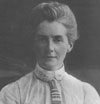 |  |
| Dr. Susan Love is committed to women's health issues. | Dr. Zeda Rosenberg is working to provide women with a way to protect themselves from contracting HIV/AIDS. | Edith Cavell was a nurse who risked her own safety to help others during WWI | Edmonia Lewis was a 19th century sculptor. |
 |  |  |  |
| Edna St. Vincent Millay 's poetry was both popular and critically acclaimed. | Eleanor of Aquitaine was a powerful and independant woman in the Middle Ages. | Eleanor Roosevelt was a champion for freedom. | Elizabeth Blackwell opened the first medical school for women. |
 |  |  |  |
| Elizabeth Cady Stanton was a pioneer in the movement for womens rights. | Elizabeth Glaser created the Pediatric AIDS Foundation. | Elizabeth Jane Cochrane (Nellie Bly) was a journalist who went around the world in 72 days. | Ellen Church pioneered the idea of having flight attendants on flights. |
 |  |  |  |
| Ellen MacArthur has broken numerous records with her courageous solo sailing adventures. | Emily Dickinson wrote nearly 2,000 poems in her lifetime. | Emily Greene Balch received the Nobel Peace Prize in 1946. | Emma Lazarus wrote the poem inscribed on the Statue of Liberty. |
 |  |  |  |
| EMME ARONSON is the first plus size supermodel. | Erin Gruwell teaches freedom through reading and writing. | Fateme was the prophet Mohammad's daughter and a leader to the people. | Fati Kirakoya: L'Oreal-UNESCO, Women in Science Fellow is a researcher committed to helping find solutions to end the AIDS crisis. |
 |  |  |  |
| Fay Clayton is an attorney who works pro bono assisting civil rights cases. | Florence Griffith-Joyner was one of the greatest athletes of all time. | Florence Kelley was an outspoken leader against child labor. | Florence Ngobeni urges African leaders to work for AIDS prevention. |
 |  |  |  |
| Florence Nightingale revolutionized nursing. | Frances Ellen Watkins was a prolific author and poet who devoted her life to speaking out against slavery. | Frida Kahlo was an artist and survivor. | Gail Kaaialii: Biologist investigates the origins of life and helps others value all life forms. |
 |  |  |  |
| Gerda Klein is a Holocaust survivor who works to end childhood hunger | Gertrude B. Elion developed the AIDS drug, AZT. | Gina Gallant is an inventor whose passion is protecting the environment. | Grace Murray Hopper was a computer visionary. |
 |  |  |  |
| Harriet Tubman organized the Underground Railroad. | Hattie Elizabeth Alexander saved the lives of thousands of children through her work. | Hazel Barton combines her passion for caving with researching microbes. | Helen Adams Keller wrote about her own life and education. |
 |  |  |  |
| Helen Freeman survived the Holocaust and shares her story. | Helene Gayle is one of the leading authorities on AIDS research. | Hermine Santrouschitz (Miep Gies) , for two years, kept Anne Frank and her family safely hidden from the Nazis. | Ilse Bing was a remarkable poet and photographer. Her works withstand the test of time. |
 |  |  |  |
| Inez Milholland Boissevain : a brief but spectacular life dedicated to women's suffrage. | Irene Curie specialized in nuclear physics, the science of studying the nucleus of the atom. | J.K.Rowling is the author of the Harry Potter books. | Jane Mt. Pleasant is an agricultural scientist who looks to the past to meet today's farming needs. |
 |  |  |  |
| Janet Guthrie First woman to race in the Indianapolis 500 | Janet Jagan was the first female president of Guyana. | Jessie Christopherson helps the physically and mentally challenged accomplish things they never thought possible. | Jessie Daniel Ames worked openly and actively on behalf of racial justice. |
 |  |  |  |
| Joan of Arc died for her beliefs. | Jody Williams began a campaign to ban landmines. | Judit Polgar is breaking the gender barrier in the world of chess. | Judy Warner worked to create a public technology high school. |
 |  |  |  |
| Julia Hill brought public attention to deforestation in California. | Julie Krone a female jockey and first woman to win the Triple Crown | Karla Diane Hurrell and her husband have fostered over 150 children. | Kathy Eldon inspired by her son, works for peace and tolerance. |
 |  |  |  |
| Kathy Sullivan was the first American woman to walk in space. | Katie Lee is a passionate advocate for wilderness. | Kelly Perkins climbs mountains to raise support for organ donation. | Kory Johnson was honored with the Goldman Environmental Prize in 1998. |
 |  |  |  |
| Laura Ingalls Wilder offered young readers a glimpse of American life in the 1800s. | Libby Riddles won the Iditarod dog sled race in 1985. | Lillie Hitchcock-Coit was a turn of the century firefighting hero. | Lucy Stone was a pioneer for womens rights. |
 |  |  |  |
| Luz Maria Rodriguez-Fernandez conducts cancer research to help understand the disease process. | Madam C.J. Walker used her business success to oppose racial discrimination. | Madame Curie received the Nobel Prize for her discovery of Radium. | Madeleine L'Engle 's most famous novel is A Wrinkle In Time. |
 |  |  |  |
| Mae Jemison dreamed of going to space since childhood. | Magdalena Hurtado is an anthropologist who studies the Ache people of Paraguay. | Margot Fonteyn was a world-renowned dancer. | Maria Josephine Barrios Filipina poet and activist |
 |  |  |  |
| Maria Montessori developed a new approach to education. | Marian Anderson was a world-renowned opera singer. | Marian Wright Edelman is one of the country's leading advocates for children. | Marie Curie discovered radioactivity as an atomic property, opening the door to 20th century science. |
 |  |  |  |
| Marjory Stoneman Douglas worked tirelessly to preserve the Everglades. | Mary Baker Eddy was the founder of Christian Science. | Mary Edwards Walker was the first and only woman to receive the U.S. Congressional Medal of Honor | Mary Harris Jones worked to free children from industrial slavery. |
 |  |  |  |
| Mary Lou Naso & Harry visit hospitals to spread smiles. | Mary Lyon established the U.S.'s first college for women. | Maxine Waters is a Congresswoman who works fervently for her community. | Maya Angelou is a writer and poet. |
 |  |  |  |
| Maya Lin is an architect and sculptor. | Meenakshi Wadhwa studies meteorites and the processes involved in their formation. | Mia Hamm has inspired the next generation of women athletes. | Mildred "Babe" Didrikson excelled in every sport she played. |
 |  |  |  |
| Mother Teresa gained international prominence as a modern-day saint. | Mrs. Mei Ng: Friends of the Earth (Hong Kong) uses education to foster environmental awareness in China | Nawal El Saadawi continued writing while in prison, her words could not be silenced. | Nellie McClung believed in equal rights for all women |
 |  |  |  |
| Nickole Evans is using technology for peace. | Ntozake Shange : 'world-class energizer of the word.' | Oprah is a powerful and charitable daytime talk-show host. | Oriana Fallaci is an important Italian journalist. |
 |  |  |  |
| Oseola McCarty donated her life savings so others could go to college. | Phillis Wheatley was the first distinguished African-American poet. | Picabo Street is one of the greatest alpine skiers ever. | Pleasant T. Rowland created the American Girls Collection. |
 |  |  |  |
| Princess Diana campaigned passionately for various causes. | RA Kartini fought for women's rights in Indonesia | Rachel Carson was the mother of the environmental movement. | Raden Ajeng Kartini worked for the rights of women in Indonesia |
 |  |  |  |
| Raja Weksler helped her daughter survive in a concentration camp. | RAWA promote women's rights through non-violent action | Rigoberta Menchu Tum was the first Guatemalan to receive the Nobel Peace Prize. | Roberta Guaspari-Tzavaras uses music to inspire children to learn. |
 |  |  |  |
| Robyn Van En worked to save organic farming businesses in North America. | Rokhaya Gueye treats malaria and raises awareness about women's health issues in Senegal. | Rosa Parks made history when she refused to sit in the back of the bus. | Rose Marie Thomas donated time and effort to combatting childhood catastrophic diseases. |
 |  |  |  |
| Ruby Bridges bravely led the way to desegregation of schools as a child. | Ruth Simmons is breaking down barriers in the world of higher education. | Sacajawea guided Lewis and Clark across the northwestern territories. | Sadako Sasaki inspired an international peace movement. |
 |  |  |  |
| Sally Fox produced a cotton that naturally comes in different colors. | Sally Ride was the first American woman to go into space. | Sandra Postel believes in the importance of water conservation. | Sandra Schmirler was Saskatchewan's beloved curling champion. |
 |  |  |  |
| September McGee is an artist and a teacher. | Shania Twain is a beloved country music singer who overcame the odds. | Shannon Hackett studies the genetic diversity and evolution in tropical birds. | Sojourner Truth born into slavery, worked for the freedom of all. |
 |  |  |  |
| Sor Juana Inez de la Cruz couldn't live without learning. | Stephanie Jenouvrier UNESCO-L'Oreal Women in Science Fellow is a population ecologist researching the effects of climate change on emperor penguins. | Susan B. Anthony led the early Women's Suffrage Movement. | Suzanne Mubarak educates the children of Egypt and the world. |
 |  |  |  |
| Sylvia Earle is a marine biologist and ambassador of the oceans. | Tania Ruiz is an astrophysicist committed to science education and helping women reach their goals. | Titiek Puspa with her music and compassionate lyrics has inspired women throughout Indonesia. | Usha Varanasi is the first woman to lead a Fisheries Science Center. |
 |  |  |  |
| Venus Williams won the 2000 US Open tennis tournament. | Wang Yani has been painting since she was three years old. | Waris Dirie works to protect the rights of women. | Wilma Rudolph was the first American woman to win 3 Olympic gold medals. |
 |  | ||
| Women Heroes Of the Early West were strong, valiant women who broke social constraints. | Zohra Ben Lakhdar is a physicist from Africa who does research on atomic spectroscopy. |
Last changed on: 3/18/2006 7:19:32 PM
|
angel | animals | artists | business | child | community | earthkeepers |explorers | faith | family | freedom | lifesavers | literary | musician | heroes in the news | peacemakers | poets | scientists | sports | teachers | women | writers |
